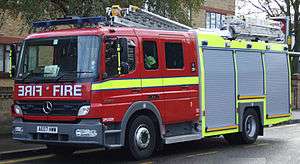
Shotgunning
Shotgunning is a means of consuming a beverage, particularly beer, very quickly by punching a hole in the side of the can, near the bottom, placing the mouth over the hole, and pulling the tab to open the top. The beer quickly drains, and is quickly consumed.
A related technique, strawpedoing or snorkeling, is used for containers not easily punctured such as a glass bottle. A straw is inserted into the bottle to similar effect.
The technique increases beverage delivery since the extra hole allows the liquid to leave while air enters simultaneously through the main hole. The bottleneck, created where air entering the container must travel through the same orifice as liquid leaving, is removed.
Technique
To shotgun a beverage, a small hole is punched in the side of the can, close to the bottom. In order to prevent the liquid from spilling out while the cut is made, the can is held horizontally, tilted slightly, and the hole is made in the resulting air pocket. The hole can be made with any sharp object. Typically a key, bottle opener, pen, knife, other sharp instrument is used. The drinker then places their mouth over the hole while rotating the can straight up. When the can's tab is pulled, the liquid will quickly drain through the hole into the drinker's mouth.

Fire engine
A fire engine (also known in some territories as a fire apparatus, fire truck, or fire appliance) is a vehicle designed primarily for firefighting operations. In addition, many fire departments often employ their vehicles for various other uses including emergency medical services and rescue purposes. The terms "fire engine" and "fire truck" are often used interchangeably but in North America represent different types of vehicles.
The primary purposes of a fire engine include transporting firefighters to an incident scene, providing water with which to fight a fire, and carrying other equipment needed by the firefighters. A typical modern vehicle will carry tools for a wide range of firefighting and rescue tasks, with common equipment including ladders, a self-contained breathing apparatus, ventilating equipment, first aid kits, and hydraulic rescue tools.
Many fire vehicles are based on standard vehicle models (although some parts may be upgraded to cope with the demands of the vehicle's usage). They are normally fitted with audible and visual warnings, as well as communication equipment such as a two-way radios and mobile computer technology.

Submarine snorkel
A submarine snorkel is a device which allows a submarine to operate submerged while still taking in air from above the surface. British Navy personnel often refer to it as the snort.
History
Until the advent of nuclear power, submarines were designed to operate on the surface most of the time and submerge only for evasion or for daylight attacks. In 1940, at night, a U-boat was safer on the surface than submerged because ASDIC sonar could detect boats underwater but was almost useless against a surface vessel. However, with continued improvement in methods of radar detection as the war progressed, the U-boat was forced to spend more time under water running on electric motors that gave speeds of only a few knots and with very limited range.
An early submarine snorkel was designed by James Richardson, an Assistant Manager at Scotts Shipbuilding and Engineering Company, Greenock, Scotland as early as 1916, during World War I. Although the company received a British Patent for the design, no further use was made of it—the British Admiralty did not accept it for use in Royal Navy submarines. In November 1926 Capt. Pericle Ferretti of the technical corps of the Italian Navy ran tests with a ventilation pipe installed on the submarine H 3. The tests were largely successful and a similar system was designed for the Sirena class, but was eventually scrapped; the following snorkel systems were not based on Ferretti's design.
Hamilton
Hamilton may refer to:
People
Places
Australia
- Hamilton Reach, a reach of the Brisbane River
- Electoral district of Hamilton (Queensland)
- Town of Hamilton, a former local government area
- Hamilton Town Hall, Brisbane, a heritage-listed former town hall
Hamilton (2006 film)
Hamilton is a 2006 independent drama film directed by Matthew Porterfield, set and shot in Baltimore, Maryland, USA. The film was screened at several international film festivals, including the Maryland Film Festival. It was released on DVD by The Cinema Guild as part of a two-disc set with Porterfield's second feature, Putty Hill, on November 8, 2011.
Plot
The film's plot deals with two accidental parents and how they manage to work their lives around being premature parents.
Cast
Production
Principal photography mostly took place in Baltimore, Maryland.
Release
The film was released at the Wisconsin Film Festival on April 2, 2006.
Home Media
The film was released on DVD on November 8, 2011
Reception
Hamilton (crater)
Hamilton is a lunar impact crater that is located near the southeastern limb of the Moon. From the Earth this crater is viewed nearly from the edge, limiting the amount of detail that can be observed. It can also become hidden from sight due to libration, or brought into a more favorably viewing position.
This crater is situated almost due east of the lava-flooded crater Oken, near the uneven Mare Australe. To the northeast of Hamilton, along the lunar limb, is the flooded crater Gum. Less than three crater diameters to the south is the flooded walled plain Lyot.
This is a nearly circular crater, although the rim to the north is somewhat straightened. It has a well-formed edge that has not been noticeably degraded through impact erosion. There are terraces along the interior sides, particularly along the western edge (which is hidden from view from the Earth.) The interior floor is deep and uneven, with an impact feature joining the midpoint to the north-northwestern inner wall.
Podcasts:

